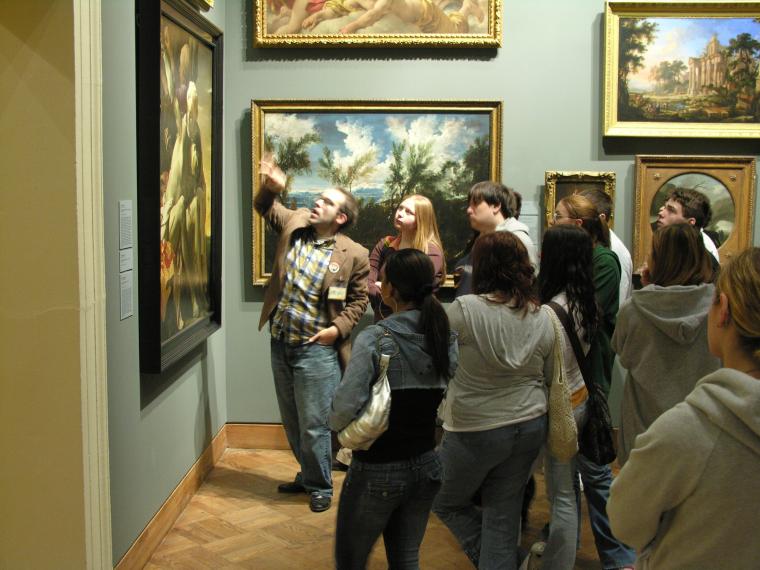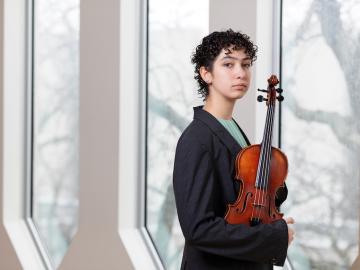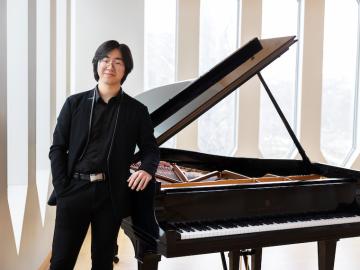Students Docents Guide Community Through Allen Memorial Art Museum
May 9, 2013
Elizabeth Kuhr

In the Allen Memorial Art Museum’s (AMAM) Ellen Johnson contemporary gallery, student docent Julia Melfi gathers the Eastwood Elementary School’s first graders into a circle.
“Let’s give the art personal space, please don’t touch,” says Melfi, a sophomore art history and theater double major. The elementary schoolers immediately silence, and turn towards Jackie Winsor's Four Corners. Using encouraging, open-ended questions such as “what is going on in this piece?” and “why does the art remind you of a big meatball monster?”, the students begin to excitedly inquire and interpret the 1,500-pound wood and hemp sculpture with Melfi.
AMAM tours educate local kids by assisting them in exploring the museum, making the space accessible and comfortable to a younger generation. Although the primary children in these tours are from the Oberlin City School District — first graders through seniors in high school, who visit as regularly as every month — the AMAM also draws in classes from surrounding schools in the greater Lorain County.
The eclectic group of 30 or so Oberlin students who work as AMAM’s docents most frequently major in history, art history, theater, and studio art, but a handful of neuroscience, chemistry, and conservatory students have taken part since the program began in 1990. With such an academically diverse bunch, the reasons to participate range from an interest in curating, a love for the AMAM, and a desire to extend art history studies beyond the classroom. College senior, history major, and studio art minor Sarah McLusky joined the program in an effort to “serve a wider community than just the college, and a community that might not have lots of other art museums to go to.”
To become a docent, current Curator of Education Jason Trimmer invites up to 20 students to apply to the Practicum in Museum Education each winter term. “It is an amazing way to bring people into the museum’s collection and break down that barrier,” said student docent and senior art history major Alex Kelly. The students meet with Trimmer in the museum every afternoon during January from 1 to 5 p.m.
Based on a model he learned at the Art Institute of Chicago, Trimmer teaches the Oberlin students to use Visual Thinking Strategies (VTS) when touring. Docents pose open-ended questions, emphasizing the visitor’s critical analysis of the art. “Our docents don’t lecture,” Trimmer explained, “they lead discussions and try to create an engaging environment on works of art.”
This strategy encourages the younger visitors to apply imagination and develop a critical perspective when interpreting art. The docents push the students to provide proof with every comment.
“They’ll say stuff that you hadn’t thought of, that’s completely legitimate and from a fresh and untainted perspective,” said college junior and art history major Meriel Stein. “They got there on their own. I think that’s a really empowering thing.”
As well as leading tours for local students, docents help organize other museum activities, such as weekly “Object Talks”, student-led mini lectures on an AMAM piece they studied during winter term. They also direct visitors touring the Weltzheimer/Johnson House, designed by Frank Lloyd Wright, and assist with tours onFirst Thursdays, the first Thursday of every month when the AMAM is open until 8 p.m. and offers programs such as poetry readings or music throughout the evening.
The docent program provides students with skills that allow them entry into many other opportunities in the museum. Sophomore art history major Emma Kimmel, for example interns with Trimmer in the museum’s educational department. She helps with administrative business such as research projects and blogging, prepares kids activities for community days, and coordinates and runs workshops under the museum’s partnership with Oberlin’s Firelands Association for the Visual Arts gallery (FAVA).
In addition, students’ work experiences with the AMAM’s docent program provide them with an advantage in the professional world. Trimmer explained that part of the winter term focuses on résumé and cover letter writing as well as discusses the various positions that exist in museums, to best prepare students for when they apply for jobs.
And the students appreciate the benefits of this training. “You have all this different experience with an actual institution and with a real collection,” said Kelly, “I think its one of the most useful things that the college does.” Recent alumni of the program have gone on to work in institutions such as the Museum of Modern Art in New York City, the Dayton Art Institute, the Studio Museum in Harlem, and the Cleveland Museum of Art.
“More often than not, students [of this program] have been able to obtain post-graduate internships, fellowships, or entry level jobs in the museum field,” says Trimmer. “I always joke that they’re going to have to hire me when they’re director of the Met!”
To learn more about the student docent program, visit the AMAM website.
Tags:
You may also like…
Students Create Project That Engages Local Hospital Patients and Nursing Home Residents
June 4, 2024
Oboist Meera Bhatia ’23 and flutist Emily Nixon ’23 visited local hospital and nursing homes over the past academic year, commissioning and premiering a piece by Jeff Scott through the Gletherow-Young-Deppman Project Award.
Violinist Maya Irizarry Lambright to Solo with Oberlin Orchestra
May 9, 2024
A winner of the 2023-24 Senior Concerto Competition, Lambright will open the program with Shulamit Ran's Violin Concerto. The second half of the program features the orchestra in Nikolai Rimsky-Korsakov's Scheherazade.
Pianist Jiongli Wang to Perform with Oberlin Chamber Orchestra
May 2, 2024
On Friday, May 3, the Oberlin Chamber Orchestra performs a program that will showcase Concerto Competition winner Jiongli Wang in Frédéric Chopin’s First Piano Concerto, as well as fourth-year composition student Cashel Day-Lewis in the premiere of his Black River Prelude commissioned by Oberlin Conservatory in honor of the Lorain County Bicentennial.


